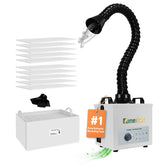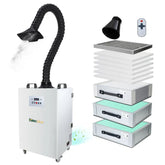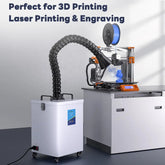How to Choose a Solder Fume Extractor
When working with electronics, circuit boards, or any soldering application, exposure to smoke and fumes is inevitable. These fumes often contain harmful particles and volatile organic compounds (VOCs), which can pose serious health risks over time. That’s why using a solder fume extractor—also known as a soldering fume extractor—is no longer optional for professionals and hobbyists alike. But with so many options on the market, how do you choose the right one?
How to Choose a Solder Fume Extractor
The key to choosing a good solder fume extractor lies in understanding both your working environment and the machine’s core filtration performance. Here are the most important criteria to consider:
1. Filtration Efficiency
A reliable soldering fume extractor should include a multi-stage filtration system—typically a pre-filter for capturing dust, a HEPA filter for fine particles (as small as 0.3 microns), and an activated carbon filter for removing odors and chemical gases. Without a high-grade filter combination, fumes may still linger in the air, even if the smoke appears to be gone.
2. Airflow & Suction Power
Airflow is usually measured in CFM (Cubic Feet per Minute). If the extractor lacks sufficient suction, it won’t effectively capture fumes at the source. Look for models with adjustable airflow to match different soldering intensities. For single-station setups, a moderate airflow may be enough. For continuous or large-scale soldering, stronger suction is essential.
3. Noise Level
Since soldering work often requires long hours of concentration, a low-noise soldering fume extractor is highly desirable. A good unit operates under 55 decibels, making it suitable for quiet labs or shared workspaces.
4. Filter Replacement & Maintenance
No matter how good the extractor is, filters will eventually need replacing. Consider the lifespan of each filter layer and how easy it is to access and replace them. Also, check whether replacement filters are affordable and readily available.
5. Portability and Flexibility
A well-designed solder fume extractor should include a flexible, adjustable suction arm that can be positioned directly above the soldering point. This ensures maximum efficiency. Some models also feature caster wheels or compact designs for easy mobility between stations.
6. Certification & Safety
Make sure the extractor is certified by trusted agencies such as CE, FCC, or RoHS. This not only guarantees a minimum standard of quality but also ensures the machine is safe for long-term operation.
In summary, choosing the right solder fume extractor is all about balancing safety, efficiency, and convenience. Whether you're a professional engineer or a DIY electronics hobbyist, investing in a high-quality soldering fume extractor will significantly improve air quality at your workstation and help protect your long-term health. Don’t just focus on price—consider what your lungs are worth.































Leave a comment
All blog comments are checked prior to publishing